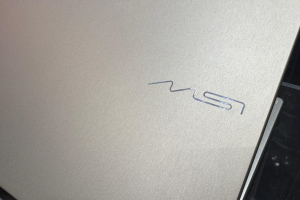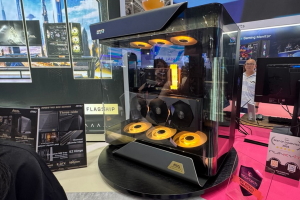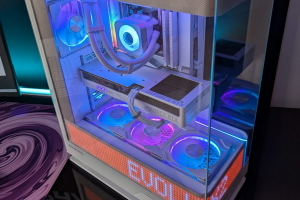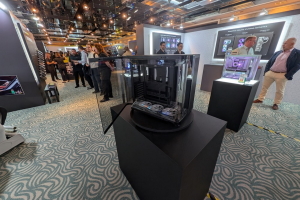Windows 10, rilasciato nuovo update cumulativo per la 1809: la lista delle novità

Un po' a sorpresa e a una settimana dal Patch Tuesday del mese di Aprile Microsoft ha rilasciato un nuovo corposo aggiornamento cumulativo. Nella pagina riportiamo tutte le novità
di Nino Grasso pubblicata il 03 Aprile 2019, alle 20:01 nel canale Sistemi OperativiWindowsMicrosoft
A circa una settimana dal Patch Tuesday Microsoft ha aggiornato il suo Windows 10 October 2018 Update, noto anche come versione 1809. Si tratta dell'ultimo major update del sistema operativo, che viene aggiornato con una lunga lista di piccoli fix. Non è obbligatorio, quindi se non lo installate niente paura: tutte le novità verranno accorpate nella patch che verrà rilasciata il secondo martedì del mese. È da segnalare che in arrivo nelle prossime settimane dovrebbe esserci anche Windows 10 19H1, il prossimo feature update del SO Microsoft.

La nuova patch viene identificata con il codice KB4490481, e porta la build al numero 17763.404. Può essere scaricata via Windows Update, al solito, o manualmente qui. Di seguito elenchiamo l'intera lista delle novità, ma prima riportiamo i bug noti: il primo fra quelli segnalati da Microsoft è relativo a WININET.DLL, che presenta un bug che provoca problemi nell'autenticazione dell'utente con Internet Explorer 11 e tutte le altre app che ne fanno uso. Il problema si manifesta quando due o più utenti usano contemporaneamente lo stesso account su più sessioni nella stessa macchina Windows Server.
Ci sono inoltre problemi con MSXML6, che provoca l'arresto anomalo delle applicazioni in alcune circostanze, problemi con i gestori Custom URI Schemes for Application Protocol su Internet Explorer, problemi con il Preboot Execution Environment durante l'avvio di un dispositivo da un server Windows Deployment Services (WDS), e infine problemi di schermate blu con l'abilitazione degli EUDC (end-user-defined-character) utilizzati soprattutto nelle regioni asiatiche. Si tratta, è meglio specificarlo, di bug che nella stragrande maggioranza dei casi non coinvolgeranno l'utente "consumer".
Ecco invece la lista delle novità:
- Addresses an issue that occurs on machines that have multiple audio devices. Applications that provide advanced options for internal or external audio output devices may stop working unexpectedly. This issue occurs for users that select an audio output device different from the “Default Audio Device”. Examples of applications that may stop working include Windows Media Player, Realtek HD Audio Manager, and the Sound Blaster Control Panel.
- Includes a fix for Game Mode that ensures the feature will no longer impact your experiences when using the industry’s top streaming and recording software.
- Enables activation of insider builds of Windows 10 Enterprise for Virtual Desktops in Microsoft Azure. Microsoft Azure is the only tested and supported platform to host Windows 10 Enterprise for Virtual Desktops, which is a key part of Windows Virtual Desktop.
- Addresses an issue that may cause the loss of Favorites or the Reading List in Microsoft Edge after updating the operating system.
- Addresses an issue that causes Internet Explorer to randomly stop working while browsing.
- Addresses an issue with scrolling ActiveX content in a window in Internet Explorer 11 during a user-triggered scroll operation.
- Addresses an issue that prevents the operating system from loading new icon files if it encounters a badly formatted icon file.
- Updates time zone information for São Tomé and Príncipe.
- Updates time zone information for Kazakhstan.
- Updates time zone information for Buenos Aires, Argentina.
- Addresses an issue that prevents the “Turn off app notifications on the lock screen" policy from working. The path is "Computer Configuration\Administrative Templates\System\Logo".
- Addresses an issue in which the graphics device interface (GDI) DeleteObject() may cause the calling process to stop working when both of the following conditions are true:
- The calling process is a WOW64 process that handles memory addresses larger than 2 GB.
- The DeleteObject() is called with a device context that is compatible with a printer device context.
- Addresses an issue that prevents applications and callers from connecting to destination endpoints when they use network interfaces that don’t have a default gateway. This issue affects the following:
- Internet access fails on devices with DSL modems and PPPoE dial-up Internet connections (commonly used with DSL modems).
- Modern and Microsoft Store apps behave as if there is no Internet access on devices with DSL modems.
- Web browsers and Win32 applications that are connected to the Internet are not affected by this issue.
- Addresses an issue that causes Windows to reuse an expired Dynamic Host Configuration Protocol (DHCP) lease if the lease expired while the OS was shutdown.
- Addresses an issue that causes the RemoteApp window to come to the foreground and to always remain active after closing a window.
- Addresses an issue that prevents the authentication credentials dialog from appearing when an enterprise web server attempts to connect to the Internet.
- Addresses an issue that may prevent Modern apps icons from appearing in the Taskbar and the Task Switcher during a RemoteApps connection.
- Addresses an issue that causes certain Microsoft Store applications to fail to launch or stop working, including WeChat on the Universal Windows Platform (UWP).
- Addresses an issue that fails to register USB cameras correctly for Windows Hello after the out of box experience (OOBE) setup.
- Adds a new Group Policy setting called “Enable Windows to soft-disconnect a computer from a network”. This determines how Windows will disconnect a computer from a network when it determines that the computer should no longer be connected to the network.
- If enabled, Windows will soft-disconnect (disconnection is not immediate or abrupt) a computer from a network.
- If disabled, Windows disconnects a computer from a network immediately.
- If not configured, the default behavior is soft-disconnect. For more information about soft-disconnect, see Understanding and configuring Windows Connection Manager.
Path: Computer Configuration\Policies\Administrative Templates\Network\Windows Connection Manager
- Addresses an issue that prevents a virtual smart card from starting when running in conjunction with Citrix 7.15.2000 Workstation VDA software.
- Addresses an issue that prevents users from configuring their screens for high-dynamic-range (HDR) video playback.
- Addresses an issue with the Windows lock screen that prevents users from unlocking a device after multiple smart card users have used the same device. This issue occurs when you attempt to use a workstation that another user has locked.
- Addresses a memory leak that occurs when a system processes logon sessions.
- Addresses an issue that causes Always-On VPN exclusion routes to only work for link-local exclusions.
- Addresses an issue that causes certificate renewal to fail when using CERT_RENEWAL_PROP_ID with the ICertPropertyRenewal interface.
- Addresses an issue that mutes the sound of single-use applications, typically used in kiosk scenarios, after the system resumes from Sleep.
- Addresses an issue to meet GB18030 certificate requirements.
- Addresses an issue that slows server performance or causes the server to stop responding because of numerous Windows firewall rules. To enable this solution, use regedit to modify the following and set it to 1:
- Type: “DeleteUserAppContainersOnLogoff” (DWORD)
- Path: HKEY_LOCAL_MACHINE\SYSTEM\CurrentControlSet\Services\SharedAccess\Parameters\FirewallPolicy
- Addresses an issue that prevents the decryption of data using Windows 10, version 1703 or later versions of Windows. This issue occurs if you encrypted that data using DPAPI-NG or a group-protected PFX file on Windows 10, version 1607, Windows Server 2016, or earlier versions of Windows.
- Addresses an issue with evaluating the compatibility status of the Windows ecosystem to help ensure application and device compatibility for all updates to Windows.
- Addresses minor issues with unknown options (unknown OPT) in the Extension Mechanisms for DNS (EDNS) for the Windows DNS Server role.
- Addresses a timing issue that may result in an access violation when configuring Switch Embedded Teaming (SET).
- Addresses an issue with the Remove-StoragePool PowerShell cmdlet that fails to clear pool metadata on NVDIMM physical disks.
- Enables X2APIC support for AMD platforms to support 256 or more logical processors on Windows Server 2019.
- Addresses an issue that prevents date parsers from converting future and past dates (Gregorian and Japanese) in compound documents (formerly OLE) to a relevant Japanese Era date. For more information, see KB4469068.
- Addresses an issue that prevents users from enabling gan-nen support for the Japanese Era. For more information, see KB4469068.










 DJI Mavic 4 Pro: sblocca un nuovo livello per le riprese aeree
DJI Mavic 4 Pro: sblocca un nuovo livello per le riprese aeree Idrogeno verde in Europa: nuovi studi prevedono costi ben superiori alle aspettative
Idrogeno verde in Europa: nuovi studi prevedono costi ben superiori alle aspettative Mario Kart World lancia Switch 2: la magia Nintendo ora in 4K
Mario Kart World lancia Switch 2: la magia Nintendo ora in 4K Redmi Pad 2, i nuovi tablet Xiaomi costano a partire da 200 euro: ecco le novità
Redmi Pad 2, i nuovi tablet Xiaomi costano a partire da 200 euro: ecco le novità All'aeroporto di Fiumicino il più grande sistema di accumulo italiano con batterie EV usate
All'aeroporto di Fiumicino il più grande sistema di accumulo italiano con batterie EV usate HONOR 400 vs HONOR 400 Pro: tutte le differenze, le specifiche e i punti di forza a confronto
HONOR 400 vs HONOR 400 Pro: tutte le differenze, le specifiche e i punti di forza a confronto Nintendo Switch 2 debutta oggi nei negozi! Prezzo e dettagli
Nintendo Switch 2 debutta oggi nei negozi! Prezzo e dettagli Samsung Galaxy S25 Edge è disponibile in Italia! Lo smartphone sottile, potente e intelligente come mai prima
Samsung Galaxy S25 Edge è disponibile in Italia! Lo smartphone sottile, potente e intelligente come mai prima  Nothing presenterà le sue prime cuffie over-ear il prossimo 1° luglio insieme a Phone(3)
Nothing presenterà le sue prime cuffie over-ear il prossimo 1° luglio insieme a Phone(3)  Le nuove soluzioni Lenovo per lo storage e oltre: ThinkAgile, ThinkSystem e gli AI Starter Kit
Le nuove soluzioni Lenovo per lo storage e oltre: ThinkAgile, ThinkSystem e gli AI Starter Kit Netatmo presenta la nuova Stazione Meteo ORIGINAL: aggiornata, potenziata con misurazione pollini e UV
Netatmo presenta la nuova Stazione Meteo ORIGINAL: aggiornata, potenziata con misurazione pollini e UV Cybersecurity: Fortinet rende disponibile Workspace Security Suite e aggiorna FortiDLP
Cybersecurity: Fortinet rende disponibile Workspace Security Suite e aggiorna FortiDLP Netatmo Stazione Meteo ORIGINAL: il ritorno di un’icona, più smart che mai
Netatmo Stazione Meteo ORIGINAL: il ritorno di un’icona, più smart che mai Il meglio dello State of Play, dal nuovo titolo di Suda51 alla collezione più completa di Mortal Kombat
Il meglio dello State of Play, dal nuovo titolo di Suda51 alla collezione più completa di Mortal Kombat Homematic IP: nuova app per ottimizzare i flussi energetici della casa
Homematic IP: nuova app per ottimizzare i flussi energetici della casa Logitech G Astro A30 LIGHTSPEED in offerta su Amazon: cuffie wireless di altissimo livello per gaming e intrattenimento
Logitech G Astro A30 LIGHTSPEED in offerta su Amazon: cuffie wireless di altissimo livello per gaming e intrattenimento Splendido TV Samsung da 65'' in offerta a 899€: Neo QLED 4K con Quantum Matrix e Dolby Atmos
Splendido TV Samsung da 65'' in offerta a 899€: Neo QLED 4K con Quantum Matrix e Dolby Atmos



















15 Commenti
Gli autori dei commenti, e non la redazione, sono responsabili dei contenuti da loro inseriti - infoTutte le versioni supportate continueranno a ricevere aggiornamenti come è prassi da sempre
Da quando è uscito l'aggiornamento 1809 appena si installano i drivers del ricevitore appare un bel BSOD. L'unica soluzione proposta dal produttore è quella di tornare alla versione precedente di Windows il che mi pare una assurdità. Quest'ultimo aggiornamento non risolve ovviamente alcunché.
Anche io che ho 3 schede audio ho problemi strani, mi piacerebbe risolvere, il problema è che non so se me lo installa sto update.
Per ora non lo forzo, vediamo che succede.
Così a naso direi che dovrebbe essere il produttore ad aggiornare i suoi driver. Non è che uno deve fare una regressione dell'intero sistema operativo perché i driver di un singolo componente non fungono. Concordo, la risposta che ti hanno dato è assurda.
Così a naso direi che dovrebbe essere il produttore ad aggiornare i suoi driver. Non è che uno deve fare una regressione dell'intero sistema operativo perché i driver di un singolo componente non fungono. Concordo, la risposta che ti hanno dato è assurda.
Con un aggiornamento di circa un mesetto fa era andata a farsi benedire la tastiera NI S88, il bug è stato fatto loro presente e dopo qualche giorno hanno comunicato che si stavano accordando con microsoft.
La colpa infatti era proprio dell'aggiornamento di Windows e NI non poteva fare altro che rimettersi a loro, dopo un mese dal problema la Microsoft ha tirato fuori il fix (lasciamo stare il fatto che l'update 1809 non mi si installa).
Si lo so, ma.........
Se dopo un aggiornamento di sistema qualcosa non funziona più, chiaramente la "colpa" è dell'aggiornamento, ma questo che significa? Che Windows non doveva aggiornare? O che i componenti devono tenere il passo? In un mondo ideale l'aggiornamento non dovrebbe creare alcun tipo di conflitto, ma considerato il numero di componenti e di produttori in gioco, direi che è virtualmente impossibile.
In passato ho avuto un paio di volte problemi con la scheda video in firma e li ho risolti andando nel sito Nvidia e installando l'ultimo driver disponibile, perché ero rimasto troppo indietro con gli aggiornamenti (ho disabilitato GEForce Experience perché mi rompe le scatole).
Anzi, ora che ci penso è un po' che non mi metto in pari con i driver Nvidia.
Da quando è uscito l'aggiornamento 1809 appena si installano i drivers del ricevitore appare un bel BSOD. L'unica soluzione proposta dal produttore è quella di tornare alla versione precedente di Windows il che mi pare una assurdità. Quest'ultimo aggiornamento non risolve ovviamente alcunché.
Successe anche a me con un altro ricevitore DVB-USB qualche anno e qualche edizione di Windows 10 fa, pensa che eravamo ancora nel 2015, quindi agli inizi della carriera di questo sistema operativo. Ora non mi ricordo il modello in questione ma per me l'unica soluzione fu quella di sostituirlo, purtroppo...
Devi effettuare il login per poter commentare
Se non sei ancora registrato, puoi farlo attraverso questo form.
Se sei già registrato e loggato nel sito, puoi inserire il tuo commento.
Si tenga presente quanto letto nel regolamento, nel rispetto del "quieto vivere".